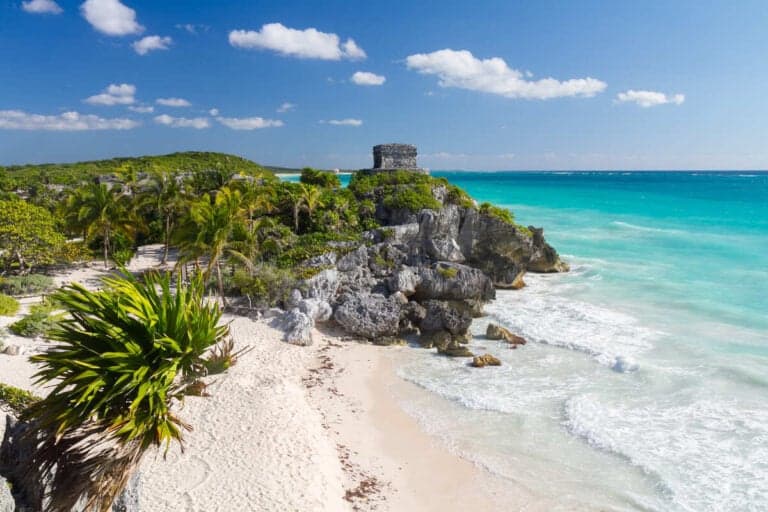In the highly unlikely case you’ve never heard of Tulum, Mexico’s liveliest coastal spot, you’ve still probably seen that iconic postcard view of a historic temple sitting on a cliff’s edge facing turquoise blue waters, do the rounds on social media lately.
If not, check it out below; it’s a looker 🤩.
Tulum is one of the most popular destinations in Mexico, and with its long miles of semi-virgin white sands, gorgeous swimming spots, and unique combination of modern coastal resorts and ancient culture, it woos millions of tourists every year, but as of late, overtourism has been taking its toll.
From crowding in public beaches to littering in the historical zone, Tulum is no longer the serene seaside town it once was, though local authorities will do everything in their power to preserve the local heritage.
That is why they are now introducing a new set of rules American travelers must observe when visiting in order to maintain public order and keep Tulum clean:
What Are The New Rules For Visiting Tulum?
As scenic as the resort-lined beachfront may be, and even if you’re only in it for some relaxation, no visit to Tulum is complete without a tour of the archaeological complex, where all of the most ancient structures and Mayan-era buildings are found.
In fact, it is the most visited historical monument in all of Mexico, and while that proves demand for culture-based activities is on the rise, the volume of tourism has proved detrimental to the preservation of the heritage zone, which is about 820 years old.

In order to better protect the ruins, as well as the lush nature around them, which together comprise the Tulum National Park, authorities have introduced a series of new visitation rules tourists must familiarize themselves with to avoid getting scolded by guards or even issued a hefty fine.
In sum, as of January, they have been prohibited from consuming food and drinks purchased outside the park during their visit, reportedly in an attempt to reduce littering in the protected preserve.
As expected, some tourists did not refrain from voicing their frustration.

That Mexican heat is no joke, and it’s common for parkgoers to bring their own water bottle and snacks to keep hydrated while exploring the area, and though many have continued to do so, especially when managing to bypass spot security checks, it is now officially forbidden.
What Are The Consequences For Breaking These Rules?
Disrespecting rules can have consequences, including fines of up to 5,000 Mexican pesos, the equivalent to $250 or more, depending on the seriousness of the infraction, and while you are unlikely to be severely punished for munching on a cereal bar, you don’t want to get reprimanded by local guards.

In addition to the bottled water and food restrictions, visitors are also being reminded not to disturb the local flora, such as picking rare flower specimens or stepping onto cordoned-off green zones, and to avoid interacting with and feeding the wildlife that call Tulum home.
You can still admire Tulum’s rich biodiversity, so long as you stick to the well-delineated walking trails, and do not verge off path and/or contaminate the nature around you, as it is part of an incredibly delicate ecosystem.
Other Rules That Must Be Observed When Visiting A Mayan Ruin

These all sound like a reasonable enough ask, but if you’ve never visited an archaeological zone before and you’re unsure how to behave, following guidance from the Society for American Archaeology will help you avoid making an embarrassing gaffe, or even worse, breaking local laws:
- Never move or disturb anything from the cultural site
- If finding an uncatalogued object, feel free to examine but avoid touching
- Never step over ancient structures unless allowed to
- Stay on the tourist-friendly path to preserve the original state of the historical site
- Never lean, sit, stand, or climb historic walls, except when it’s permitted
- Dispose of your waste appropriately
- Avoid bringing pets into archaeological zones, and make sure children are supervised at all times

Why Is It Important To Keep Tulum Well-Preserved?
Tulum is among the oldest and most historically charged settlements in the Mexican Caribbean.
It was founded by the indigenous Mayan peoples between the 14th and 15th centuries, long before the first American colonies were established.
Though it is now a modern town packed with resorts, beach clubs, and other entertainment venues, it retains much of the ancient Mayan character.
This quality the much-larger Cancun further up the coast lacks as a 50-year-old planned city built exclusively to boost tourism.

Tulum, on the other hand, is a heritage site first and foremost: back in the 1500s, it was a thriving Mayan trading hub on the shores of the Caribbean, home to ornate temples, luxurious palaces and an imposing pyramid, which Spanish colonizers named ‘El Castillo’: The Castle.
It was also one of the last Mayan strongholds to surrender to Spanish rule, as the natives stood their ground for an additional 70 years while much of the Mayan civilization around them crumbled, leaving the historical city of Tulum in remarkably good condition.

Other than boosting conservation efforts in the Tulum National Park, the municipality seems adamant about moving away from its reputation as the Mexican Caribbean’s party hub, having enacted anti-noise laws as early as 2022, and more recently, tightening security protocols.
To put it briefly, Tulum is becoming better, safer, and cleaner for tourists.
Credit: Source link

